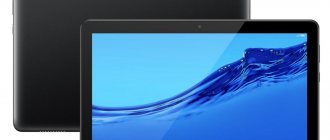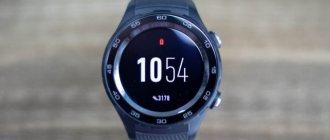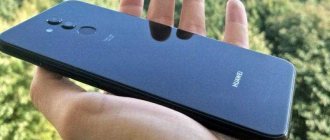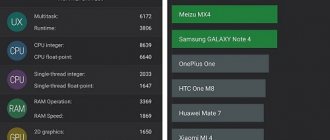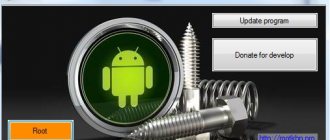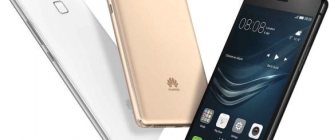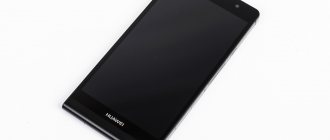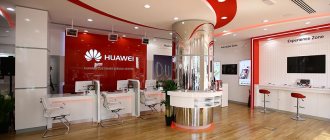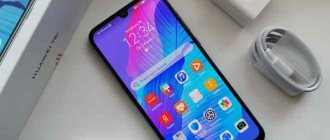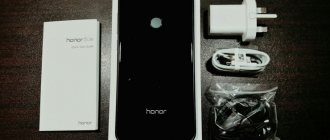Huawei has been disappointing with its prices lately. Well, let's be honest. No, undoubtedly, with their cool gadgets they have won many fans in the Russian market. But their popularity cannot yet be compared with Samsung and Apple. However, the estimated price of the new flagship of the Chinese giant will be about thirty thousand rubles. It won't be easy for him. However, it is the flagship. The light version costs almost twice as much.
The Huawei P8 family includes two models. We decided to analyze the “light” version. How is she different from her older brother? Firstly, the plastic body. Goodbye metal, we will miss you. Of course, the filling is not so cool. The battery is weaker. Well, the question immediately is: is it worth looking at it with such and such an approach?
- Reviews
- Video reviews
- Prices
- Photo
- conclusions
- Alternative
- Links
Review Analysis
Huawei P8 Lite review: flagship design is much cheaper
Huawei P8 Lite is a good attempt to sell the design of the flagship P8 much cheaper: externally, the smartphones are almost indistinguishable.
It has a normal hardware platform (RAM, processor), good cameras, and interface for its price (let me remind you, 17,990 rubles). But 2 SIM cards are implemented strangely: if you want a second card, give up the memory card, and the built-in array is only 16 GB. However, Samsung Galaxy A, Meizu m2 note and some other models have the same implementation. The screen is also not the best: if the resolution is usual, then the viewing angles could have been wider. Officially, P8 Lite costs 17,990 rubles (you can find it cheaper). The main competitors cost about the same: the Lenovo S90 and ZTE Blade S6 smartphones similar to the iPhone 6. But Lenovo has 2 SIM cards and 32 GB of memory, an all-metal body and a front camera with a flash, while the ZTE Blade S6 wins in price and screen quality. So the Huawei P8 Lite will not be bad, but there are few reasons to choose it over its competitors. The main one is the appearance of the flagship P8.hi-tech.mail.ru
Verdict:
7.8
The price is high compared to competitors
Despite all the simplifications made in comparison with the flagship, its fleshed-out version Huawei P8lite managed to maintain a stylish design, having received a relatively thin body made of composite material.
At the same time, the smartphone’s features include advanced shooting capabilities, high-quality sound and support for 4G networks. In turn, the not-so-strong points of this device include the lack of brightness reserve on the screen, short battery life (when watching videos), as well as a combination slot, which allows for alternative installation of a nanoSIM card or microSD memory card. hitech.vesti.ruVerdict:
7.8
Review of the Huawei P8 Lite smartphone
The quality of communication in my sample was not great; sometimes they couldn’t reach me.
Most likely the problem is with the test device. The vibration alert, despite its compact dimensions, is powerful: you can easily feel the ringing in an autumn jacket. Overall, the P8 Lite didn't impress me, and I'll tell you why. The fact is that for 4,000 - 6,000 rubles cheaper you can buy Honor 4X, which is more interesting in some respects: a large screen, a capacious battery, two microSIM cards that simultaneously operate in 2G/3G/4G mode, there is a memory card (in P8 Lite will have to sacrifice something - either memory or a second SIM card), lower price. The processor, memory, cameras are the same. Pay more because of similarity to the flagship? This is not the case because Huawei is not Apple or Samsung. Even gurus will not quickly remember the name of an expensive device from a Chinese company (no offense intended).mobile-review.com
Verdict:
7.6
Huawei P8 lite review: shoots almost like a flagship
Even though Huawei P8 lite is not a flagship, its camera takes pictures almost like a flagship.
There are some minor complaints (or rather, wishes) about it - the colors would be more saturated and the focus would be faster, but overall the camera makes a favorable impression. The camera of the new product is really not bad: a more than fast shutter release (which is important), excellent clarity, interesting, albeit few in comparison with the Huawei P8, software functions such as taking photos with floating focus. And this is at a smartphone cost of about 17,990 rubles. Conclusion - Huawei P8 lite can be safely taken as a camera for photography, you can hardly go wrong. 4pda.ruVerdict:
8.1
Huawei P8 lite review: lightweight flagship
Huawei P8 lite is certainly worthy of attention: at a price much lower than that of Huawei P8, the new product is a high-quality smartphone without obvious flaws.
Its not-so-strong (not necessarily weak) sides include average battery life and a limited set of functions in the camera app. But Huawei P8 lite works stably, you can play games on it with pleasure, and its speakers sound great. 4pda.ruVerdict:
7.8
Huawei MediaPad M3 Lite 8 review
Huawei MediaPad M3 Lite 8 is a mid-level tablet equipped with an LTE module. This Chinese device was officially presented in July 2021. It has an 8-inch screen, high-quality sound and a large amount of memory.
Appearance and ergonomics
This tablet features a minimalistic design without unnecessary elements. The aluminum case has a spectacular metal frame, and its rounded edges make the appearance of the gadget truly attractive. This is a stylish and compact device that is pleasant to hold in your hand.
Below the screen there is a navigation button along with a fingerprint scanner, and above it is the front camera. At the back is the main photo module. The device is convenient to use due to its extremely compact dimensions, as well as the pleasant-to-touch surface of the body. Available colors: gold and space gray. Dimensions of Huawei MediaPad M3 Light 8: height - 213.3 mm, thickness - 7.5 mm, width - 123.3 mm, weight - 310 g.
Display
This model has at its disposal an 8-inch high-resolution FHD screen (1920 by 1200 pixels). It uses a high-quality IPS matrix with a high contrast ratio (900:1). There is dynamic brightness control, which allows you to make the picture more beautiful and pleasing to the eye on the go. At the same time, users are able to independently adjust the display backlight using special filters. The image remains readable from a variety of angles.
Hardware and performance
The MediaPad M3 Lite 8 tablet is equipped with a budget Snapdragon 435 processor from Qualcomm. This is a full-fledged eight-core solution with Adreno 505 graphics. The processor has Cortex-A53 cores with a frequency of 1400 MHz. Instances with 3 GB of RAM are supplied to the domestic market. But the built-in storage has different volumes - 32 or 64 GB. There is also support for memory cards, the maximum capacity of which can reach 128 GB.
The device operates under Android 7.0 OS. This operating system has acquired the exclusive EMUI 5.1 shell, which increases the efficiency and smooth operation of the device. Thanks to the F2FS progressive file system, memory fragmentation does not affect overall performance. Moreover, there is no need to constantly reboot the tablet for the software to function correctly. In terms of performance, the gadget performs well; all available applications launch without failures.
Communication and sound
MediaPad M3 Light 8 can easily be called musical. Excellent sound is provided by four speakers with individual amplifiers. Thanks to this, the sound is rich and also clear. The built-in audio system was created in collaboration with the professionals at HARMAN, who truly know how to tune the sound to perfection. The proprietary SWS 3.0 technology, used for certain scenarios (games, music, movies, etc.), is also located here. LTE support is present.
Camera
The Huawei MediaPad M3 Lite 8 has two 8-megapixel cameras. They shoot well in the daytime, although in low light artifacts immediately appear. There is no flash, but there is autofocus.
conclusions
Fans of high-quality and relatively inexpensive tablets should pay special attention to the Huawei MediaPad M3 Lite 8. The gadget, priced from 18,000 rubles, has an attractive design, as well as a number of positive technical features. And the excellent sound will definitely appeal to music lovers and entertainment lovers.
Pros:
- Powerful speakers and high-quality sound.
- Practical appearance and aluminum housing.
- Fingerprint scanner and LTE module.
- Large amount of memory.
- High resolution display.
Minuses:
- There is no flash.
- Not all games run smoothly.
conclusions
We are not particularly pleased with the Huawei company. First of all, prices. Russian people are accustomed to the fact that Chinese means cheap. What do we have here? The price is quite European. It doesn't look good against the background of cheaper competitors. The quality is also at the same level as that of competitors. And let's be honest, when choosing between Huawei and Samsung, Sony or Apple, we will not choose the first. A truly undeniable advantage is that Huawei P8 lite can take photographs no much worse than Nokia, even without being a flagship. And the appearance is quite presentable. But a high price amid a crisis can greatly affect sales.
Advantages
- Appearance repeats the flagship P8
- Modern hardware platform
- Android 5.0 and user-friendly interface
- Good shooting quality
- Availability of LTE modem
Flaws
- Plastic case
- Not the best screen quality
- Combined slot for nanoSIM and microSD cards
- Short working time
- The price is high compared to competitors
Overall verdict
7.8
Alternative
- Huawei Ascend G7
- iPhone 5s Review
Technical specifications Huawei P8 Lite (2017)
| General characteristics | |
| Model | Huawei P8 Lite 2021, Huawei Nova Lite |
| Date of announcement/start of sales | January 2017 |
| Dimensions | 147.2 × 72.9 × 7.6 mm. |
| Weight | 147 |
| Case color range | Black, White, Gold |
| Number and type of SIM cards | Dual SIM (Nano-SIM, dual stand-by) |
| operating system | Android OS, v7.0 (Nougat) |
| Communication standard in 2G networks | GSM 850 / 900 / 1800 / 1900 - SIM 1 & SIM 2 |
| Communication standard in 3G networks | HSDPA 850 / 900 / 1900 / 2100 |
| Communication standard in 4G networks | LTE |
| Display | |
| Screen type | IPS LCD capacitive touchscreen, 16 million colors |
| Screen size | 5.2 inches |
| Screen resolution | 1080 x 1920 @424 ppi |
| Multitouch | There is |
| Screen protection | Emotion 5.0 UI |
| Sound | |
| 3.5mm jack | There is |
| FM radio | There is |
| Additionally | |
| Data transfer | |
| USB | microUSB v2.0 |
| Satellite navigation | GPS (A-GPS), GLONASS |
| WLAN | Wi-Fi 802.11 b/g/n, Wi-Fi Direct, hotspot |
| Bluetooth | v4.1, A2DP, EDR, LE |
| Internet connection | LTE Cat4; HSDPA, 42.2 Mbps; HSUPA, 5.76 Mbps, EDGE, GPRS |
| NFC | There is |
| Hardware | |
| CPU | HiSilicon Kirin 655 Octa-core (4×2.1 GHz Cortex-A53 & 4×1.7 GHz Cortex-A53) |
| GPU | Mali-T830MP2 |
| RAM | 3 GB RAM |
| Inner memory | 16 GB |
| Supported memory cards | microSD up to 256GB |
| Camera | |
| Camera | 13 MP, f/2.2, autofocus, LED flash |
| Camera functions | Geo-tagging, touch focus, face/smile detection, panorama, HDR |
| Video recording | [email protected] |
| Front-camera | 8 MP, f/2.0, 1080p |
| Battery | |
| Battery type and capacity | 3000 mAh, non-removable |
| Additionally | |
| Sensors | Light, proximity, fingerprint reading, accelerometer, compass |
| Browser | HTML5 |
| IMAP, POP3, SMTP | |
| Other | - Google Search, Maps, Gmail, Talk - XviD/MP4/H.264/WMV player - MP3/eAAC+/WMA/WAV/Flac player - Document viewer - Photo/video editor - Organizer - Voice dialing, voice commands, voice recording |
| Equipment | |
| Standard equipment | P8 Lite (2017):1 USB cable: 1 SIM card ejector: 1 User manual: 1 Warranty card: 1 Charger 5V / 2A: 1 |
Review of the Huawei P30 Lite smartphone
Huawei P30 Lite is the youngest representative of the flagship family of Huawei smartphones, presented to the world this spring. The basis of the model's marketing slogan. Obviously, the manufacturer considers the main advantage of the smartphone to be the presence of a separate wide-angle camera module. In the new season, the popularity of wide-angle photography among smartphone creators is growing. We will understand later whether it will be so popular among users, but for now let’s look at what the younger brother of the P30 line is capable of and whether it is worthy of bearing this proud name.
Main characteristics of Huawei P30 Lite (model MAR-LX1M)
- SoC Kirin 710, 8 cores: 4×Cortex-A73 @2.2 GHz + 4×Cortex-A53 @1.7 GHz
- GPU Mali-G51 MP4 @1 GHz
- Operating system Android 9, EMUI 9
- Touch display IPS 6.15″, 2312×1080 (19.5:9), 415 ppi
- Random access memory (RAM) 4 GB, internal memory 128 GB
- microSD support (up to 512 GB)
- Nano-SIM support (2 pcs.)
- GSM/WCDMA networks
- LTE Cat.6 networks B1/3/4/7/8/20/38
- GPS/A-GPS, Glonass, BDS
- Wi-Fi 802.11a/b/g/n/ac (2.4 and 5 GHz)
- Bluetooth 4.2 BLE, aptX, HWA and aptX HD
- NFC
- USB Type-C, USB OTG
- Audio output to headphones (3.5 mm)
- Main camera 24 MP (f/1.8) + 8 MP (f/2.4) + 2 MP (f/2.4); video [email protected] fps
- Front camera 32 MP, f/2.0
- Proximity and lighting sensors, magnetic field, gyroscope, accelerometer
- Fingerprint's scanner
- Battery 3340 mAh, fast charging 18 W
- Dimensions 153×73×7.4 mm
- Weight 159 g
| Retail offers | find out the price |
Appearance and ease of use
The Huawei P30 Lite case is made in a standard corporate design, characteristic of almost all modern models of the manufacturer. This is still the same polymer or glass with a mirror substrate in gradient colors. It is no longer possible to imagine a Huawei or Honor smartphone that would not shimmer in the light, like a Christmas tree toy.
Both the glass back and side frame are very slippery. Lacquered surfaces quickly become covered with fingerprints, practicality is once again sacrificed for beauty.
It’s nice that the side frame here is not as narrow as that of the P30 Pro, it is wider on the sides, this allows you to hold the device in your hand a little more securely, although it is still, of course, as slippery as possible.
The camera module protruding beyond the rear panel prevents the device from lying stably on a hard surface. The smartphone sways when you touch the screen and lies unsteadily.
The fingerprint scanner is located at the back, the pad is easy to feel because it is recessed deep into the phone. There are no complaints about the operation of the scanner itself: it works quickly and accurately.
I’m impressed that Huawei quickly opted for the most successful of all screen cutout options – the teardrop-shaped one. It occupies a minimal area here at the top of the screen, which is great.
The hero of the review is one of the latest smartphones from the company that supports microSD. Huawei no longer produces models that support this type of card. Here the card slot is a hybrid one; it does not support the simultaneous installation of two Nano-SIM cards and a microSD memory card; you will have to sacrifice something. Hot swapping of cards is supported.
The ill-conceived placement of the slot for installing cards at the top end is surprising. It's here next to the microphone hole, into which it's easy to mistakenly insert the shaft of a metal key to remove cards and pierce the membrane.
The hardware buttons on the side face are tactilely indistinguishable and have the same smooth surface. The keys are large, somewhat harsh, have a clear response, and are installed on one side, so there are no complaints about them.
It’s convenient that this device has a modern USB Type-C connector. You can also praise the creators for retaining the 3.5mm audio output.
Huawei P30 Lite is offered in three color options: Peacock Blue, Midnight Black and Pearl White. Russian press releases describe them as "midnight black, pearl white and rich turquoise." White, however, is not supplied to our market. The smartphone did not receive protection from dust and moisture.
Screen
Huawei P30 Lite is equipped with an IPS display covered with 2.5D Corning Gorilla Glass 3. The physical dimensions of the screen are 66x142 mm, diagonal - 6.21 inches, resolution - 2312x1080 (with an aspect ratio of 19.5:9), dot density - 415 ppi. The frame around the screen has a width of 3.5 mm on the sides, 7 mm on the bottom, and 4.5 mm on the top.
The front surface of the screen is made in the form of a glass plate with a mirror-smooth surface that is scratch-resistant. Judging by the reflection of objects, the anti-glare properties of the screen are better than those of the Google Nexus 7 (2013) screen (hereinafter simply Nexus 7). For clarity, here is a photograph in which a white surface is reflected when the screens are turned off (on the left is Nexus 7, on the right is Huawei P30 lite, then they can be distinguished by size):
The screen of the Huawei P30 lite is noticeably darker (brightness according to photographs is 105 versus 119 for the Nexus 7). The ghosting of reflected objects in the Huawei P30 lite screen is very weak, this indicates that there is no air gap between the layers of the screen (more specifically, between the outer glass and the surface of the LCD matrix) (OGS - One Glass Solution type screen). Due to the smaller number of boundaries (glass/air type) with very different refractive indices, such screens look better in conditions of intense external illumination, but their repair in the case of cracked external glass is much more expensive, since the entire screen has to be replaced. On the outer surface of the screen there is a special oleophobic (grease-repellent) coating, which is noticeably better in efficiency than that of the Nexus 7, so fingerprints are removed much more easily and appear at a lower speed than in the case of regular glass.
When displaying the white field in full screen and manually controlling the brightness, its maximum value was 460 cd/m² in normal conditions, and in very bright light it rises to 505 cd/m². The maximum brightness is very high, therefore, given the excellent anti-glare properties, screen readability even on a sunny day outdoors should be at a good level. The minimum brightness value is 1.1 cd/m². In complete darkness, the brightness can be reduced to a comfortable value. There is automatic brightness adjustment based on the light sensor (it is located to the right of the front speaker grille on the upper edge of the front panel). In automatic mode, as external lighting conditions change, the screen brightness both increases and decreases. The operation of this function depends on the position of the brightness adjustment slider: with it the user can try to set the desired brightness level in the current conditions. If you do not interfere, then in complete darkness the auto-brightness function reduces the brightness to 4 cd/m² (a little dark), in an office illuminated by artificial light (approximately 550 lux) it sets it to 130 cd/m² (normal), in a very bright environment (corresponds to clear lighting during the day outdoors, but without direct sunlight - 20,000 lux or a little more) increases to 505 cd/m² (to the maximum, as needed). The backlight brightness level depends on the position of the slider in dark and average conditions, and in very bright environments it is always set to maximum. We weren't happy with the default result, so we moved the slider a little to the right in complete darkness and for the three conditions above, we got 20, 175 and 505 cd/m² (the perfect combination). It turns out that the auto-brightness function works adequately and allows the user to customize their work to individual requirements. At any brightness level, there is no significant backlight modulation, so there is no screen flicker.
This smartphone uses an IPS matrix. The microphotographs show a typical IPS subpixel structure:
For comparison, you can see the gallery of microphotographs of screens used in mobile technology.
The screen has good viewing angles without significant color shift even with large viewing deviations from perpendicular to the screen and without inverting shades. For comparison, here are photographs in which the same images are displayed on the screens of Huawei P30 lite and Nexus 7, while the screen brightness is initially set to approximately 200 cd/m², and the color balance on the camera is forced to switch to 6500 K.
There is a white field perpendicular to the screens:
Note the good uniformity of brightness and color tone of the white field.
And a test picture:
The colors on the Huawei P30 lite screen are clearly oversaturated, and the color balance varies between screens.
Now at an angle of approximately 45 degrees to the plane and to the side of the screen:
It can be seen that the colors have not changed much on both screens, but on the Huawei P30 lite the contrast has decreased to a greater extent due to the greater highlighting of blacks.
And a white field:
The brightness of the screens at an angle has decreased (by at least 5 times, based on the difference in shutter speed), but the screen of the Huawei P30 lite is still a little darker. When deviated diagonally, the black field is brightened greatly, but remains conditionally neutral gray. The photographs below demonstrate this (the brightness of the white areas in the direction perpendicular to the plane of the screens is the same!):
And from another angle:
When viewed perpendicularly, the uniformity of the black field is good:
The contrast (approximately in the center of the screen) is high - about 1200:1. The response time for the black-white-black transition is 22 ms (11 ms on + 11 ms off). The transition between halftones of gray 25% and 75% (based on the numerical value of the color) and back takes a total of 37 ms. The gamma curve, constructed using 32 points with equal intervals based on the numerical value of the shade of gray, did not reveal any blockage in either the highlights or the shadows. The exponent of the approximating power function is 1.99, which is lower than the standard value of 2.2. In this case, the real gamma curve noticeably deviates from the power-law dependence:
This device has a dynamic adjustment of the backlight brightness with a non-obvious dependence on time and on the nature of the displayed image. As a result, the resulting dependence of brightness on hue (gamma curve) may not correspond to the gamma curve of a static image, since the measurements were carried out with sequential display of shades of gray on almost the entire screen. For this reason, we carried out a number of tests - determining contrast and response time, comparing black illumination at angles - (however, as always) when displaying special templates with a constant average brightness, and not monochromatic fields in the entire screen. In general, such non-disabled brightness correction does nothing but harm, since constantly changing the screen brightness can at least cause some discomfort.
The color gamut is wider than sRGB and almost equal to DCI:
Let's look at the spectra:
The spectra of the components are quite well separated, which determines the wide color gamut. For a consumer device, a wide color gamut is not an advantage, but a significant disadvantage, since as a result, the colors of images - drawings, photographs and films - oriented to the sRGB space (and the vast majority of them) have an unnatural saturation. This is especially noticeable on recognizable shades, such as skin tones. The result is shown in the photographs above.
However, not everything is so bad: when you select the Normal , the coverage is compressed to the sRGB boundaries.
Colors in images become less saturated (and color balance changes slightly):
The balance of shades on the gray scale after selecting the Normal is acceptable, since the color temperature is not much higher than the standard 6500 K (about 7000 K on a white field), and the deviation from the blackbody spectrum (ΔE) is below 10 (also on white), which is for consumer device is considered an acceptable indicator.
This device has the ability to adjust the color balance by adjusting the hue on the color wheel.
In the graphs below, the Vivid correspond to the results without any color balance correction ( Vivid ), and the Normal curves, corr. — data obtained after selecting the Normal and shifting the point on the circle to the position indicated in the image above. It can be seen that the change in balance corresponds to the expected result, since ΔE has decreased. There is some benefit from this correction, although the brightness has decreased by 11%. Note that this function is implemented more for show, since there is no numerical reflection of the correction and there is no special field for measuring color balance. (The darkest areas of the gray scale can be ignored, since color balance there is not very important, and the error in measuring color characteristics at low brightness is large.)
There is a fancy setting that allows you to reduce the intensity of the blue component.
Marketers tried to intimidate the user in order to show the level of care of the manufacturer. Of course, there is no harmful UV radiation (see spectrum above), and there is no eye fatigue caused specifically by blue light. In principle, bright light can lead to disruption of the circadian rhythm (see the article about the iPad Pro with a 9.7-inch display), but everything can be solved by adjusting the brightness to a comfortable level, and there is absolutely no way to distort the color balance, reducing the contribution of blue sense.
To summarize: the screen has a very high maximum brightness and has excellent anti-glare properties, so the device can be used outdoors even on a sunny summer day without any problems. In complete darkness, the brightness can be reduced to a comfortable level. It is also possible to use a mode with automatic brightness adjustment, which works adequately. Also, the advantages of the screen include an effective oleophobic coating, the absence of an air gap in the layers of the screen and flicker, high contrast, good uniformity of the black field, sRGB color gamut and good color balance (if you choose the right profile). The disadvantages are the low stability of black to the deviation of the gaze from perpendicular to the screen plane. Taking into account the importance of characteristics for this particular class of devices, the quality of the screen can be considered high.
Cameras
The Huawei P30 Lite selfie camera uses a 32 MP sensor and an f/2.0 aperture lens. In general, the front camera demonstrates good shooting quality in terms of detail and color reproduction. But in the background blur mode, the smartphone cannot accurately crop the central object at all. Work with lighting also leaves much to be desired, since the test photographs clearly have overexposure, and this is under ideal shooting conditions.
The rear camera is triple. The main module with a 24 MP sensor and an f/1.8 aperture lens is complemented by a wide-angle module (120°) with an 8 MP sensor and an f/2.4 aperture lens, as well as a module for measuring scene depth (2 MP, f/2 ,4).
The advantage of a wide-angle module is the ability to photograph large objects from a short distance (for example, fit a tall house into the frame while standing on a narrow street). Everything else in this case is a disadvantage - for example, the module does not have autofocus (!). Yes, when there is no way to move away from the subject of shooting, you don’t have to choose, but here there is no choice as such. Note, however, that the wide-angle module, even in modern flagship smartphones, is a distinctly weak link; the catastrophic drop in picture quality in comparison with the excellent main module is especially noticeable in their case. Here, in general, harmony reigns: the wide-angle camera is weak, but the main one is not particularly better.
regular lens
wide angle lens
regular lens
wide angle lens
In poor lighting, it is almost impossible to take a photo of acceptable quality handheld with a wide-angle module.
regular lens
wide angle lens
A 6x digital zoom is available, which, as always, does not bring any benefit.
Traditionally, there are several dedicated shooting modes, but there are fewer of them than usual: say, there is night and portrait, but no monochrome. In night mode, the camera simulates a long exposure mode of 4 seconds, merging several images into one. The mode is designed to eliminate the shaking of the hands of a photographer trying to shoot in the dark. However, the specific processing of night images does not allow us to talk about any serious quality. In fact, in this way you can only get a picture of blurry spots - however, it is still lighter and clearer when looking at the miniature than during normal shooting.
normal mode
night mode
normal mode
night mode
The camera’s operation in automatic modes is controlled by AI, which in real time identifies more than 500 types of scenes in 22 categories, setting the optimal shooting parameters, according to the automation. When shooting, phase detection (PDAF) and contrast detection (CDAF) autofocus are used. There is no standard option to save pictures in RAW, even in manual mode.
As we have already said, the quality of shooting with the main camera is decidedly low. Something good is achieved only in bright light, and in the shadows, even on a sunny summer day, it turns out to be a mess of pixels in an attempt to overcome noise. We called the next fragment of the photo “There is no life beyond the circle of light!” It seems to illustrate the level of the problem well.
fragment 1:1
The detail of the photographs is low, everything is blurry even in the sun, there is no need to talk about clarity (only the twigs against the sky come out clear). Obvious noises. True, it’s not in the pictures, but instead of a sunny sky there’s such a mess that it can’t serve as a consolation. In the lower left corner there is a large area of blur (which, however, does not spoil anything). In general, without looking at Exif, we would say that these are pictures of some kind of budget smartphone.
Videos can be shot at a maximum resolution of 1080p at 60 fps. There is no 4K video shooting, nor is there optical stabilization. The quality of video recording is average - both in terms of detail and sharpness, and at night the camera shoots video frankly poorly. The sound is recorded quite cleanly, without distortion in the form of an echo, but the noise reduction system cannot cope with strong wind noise.
- Video No. 1 (69 MB, 1920× [email protected] fps, H.264, AAC)
- Video No. 2 (65 MB, 1920× [email protected] fps, H.264, AAC)
- Video No. 3 (38 MB, 1920× [email protected] fps, H.264, AAC)
- Video No. 4 (26 MB, 1920× [email protected] fps, H.264, AAC)
- Video No. 5 (71 MB, 1920× [email protected] fps, H.264, AAC)
Telephone and communications
The Kirin 710 platform theoretically has a modem supporting LTE Cat.12 and Cat.13, but the official specifications do not disclose the speed capabilities of the smartphone in 4G mode. Huawei P30 Lite supports the most common LTE FDD bands in Russia (Band 3, 7, 20). In practice, within the city limits of the Moscow region, the device demonstrates reliable operation in wireless networks, does not lose connection, and quickly restores connection after a forced interruption. The Wi-Fi module supports both 2.4 and 5 GHz bands and 802.11ac mode. There is Bluetooth version 4.2 with support for the latest codecs for high-quality music playback, as well as an NFC module with support for Google Pay.
The navigation module works with GPS (dual-frequency, with A-GPS), with the domestic Glonass and the Chinese Beidou. During a cold start, searching for the first satellites takes a lot of time; satellites are discovered somewhat slowly. It’s strange, but we observe this effect when testing every smartphone on the Kirin 710. The smartphone has a magnetic compass, necessary for navigation programs.
The phone application supports Smart Dial, that is, while dialing a phone number, a search is immediately carried out by the first letters in contacts. Methods for sorting and displaying contacts are standard for the Android interface. Medium power vibration alert. There is support for VoLTE. The cards operate in Dual SIM Dual Standby mode.
Software and multimedia
The Huawei P30 Lite uses Google Android version 9 with the proprietary EMUI 9 shell as its software platform. We have already studied it so well in previous reviews that there is absolutely nothing to add. The interface allows you to choose the option of displaying a separate section with applications in the launcher or without it. This most clearly demonstrates the Chinese manufacturer’s desire to satisfy the interests of both the Asian and European markets. Flexible settings allow you to set the option to control your smartphone with one hand, gestures, voice, use special modes like gaming, clone your accounts on social networks and much more.
There is a face recognition unlock feature. Surprisingly, without a special infrared sensor, like in the iPhone, the system can work in complete darkness - for this, the screen flashes as brightly as possible for a moment, illuminating the face.
There is only one main speaker in the device. The smartphone sounds satisfactory through the speaker and not bad with headphones. For listening on headphones, the Huawei Histen audio effects system is provided, there are presets for different types of earphones, the sound is more or less clear, the volume reserve is not maximum, but there is no shortage. There is an FM radio and a high-sensitivity voice recorder, useful for recording seminars.
Performance
Huawei P30 Lite is built on a single-chip Kirin 710 system. The configuration of this SoC includes two CPU clusters: four Cortex-A73 cores with a frequency of 2.2 GHz and four Cortex-A53 with a frequency of 1.7 GHz. The Mali-G51 MP4 GPU is responsible for graphics performance.
The RAM capacity is 4 or 6 GB (the 6 GB version is not sold in Russia), the storage capacity is 128 GB (of which about 105 GB is free). Installing a microSD memory card is supported, as is connecting external devices to the USB Type-C port in USB OTG mode.
Kirin 710 is a quite decent mid-range SoC, which is produced using a 12nm process technology. The speed and smoothness of the system and any applications does not cause any complaints, as does the performance in games. All tested games, including Modern Combat 3, Mortal Kombat X, Injustice 2 and PUBG, run confidently without stuttering, although not at maximum, but at medium settings.
Testing in comprehensive tests AnTuTu and GeekBench:
For convenience, we have compiled all the results we obtained when testing the smartphone in the latest versions of popular benchmarks into tables. The table usually adds several other devices from different segments, also tested on similar latest versions of benchmarks (this is done only for a visual assessment of the obtained dry figures). Unfortunately, within the framework of one comparison it is impossible to present the results from different versions of benchmarks, so many worthy and relevant models remain “behind the scenes” - due to the fact that they once passed the “obstacle course” on previous versions of test programs.
| Huawei P30 Lite (HiSilicon Kirin 710) | Samsung Galaxy A70 (Qualcomm Snapdragon 675) | Xiaomi Mi 9 SE (Qualcomm Snapdragon 712) | Redmi Note 7 (Qualcomm Snapdragon 660) | Samsung Galaxy A50 (Samsung Exynos 9610) | |
| AnTuTu (v7.x) (bigger is better) | 139421 | 166849 | 178912 | 142298 | 143400 |
| GeekBench (bigger is better) | 1568/5478 | 2378/6424 | 1919/6017 | 1634/5633 | 1705/5216 |
Testing the graphics subsystem in 3DMark and GFXBenchmark gaming tests:
When testing in 3DMark, the most powerful smartphones now have the ability to run the application in Unlimited mode, where the rendering resolution is fixed at 720p and VSync is disabled (which can cause the speed to rise above 60 fps).
| Huawei P30 Lite (HiSilicon Kirin 710) | Samsung Galaxy A70 (Qualcomm Snapdragon 675) | Xiaomi Mi 9 SE (Qualcomm Snapdragon 712) | Redmi Note 7 (Qualcomm Snapdragon 660) | Samsung Galaxy A50 (Samsung Exynos 9610) | |
| 3DMark Ice Storm Sling Shot ES 3.1 (bigger is better) | 1002 | 976 | 2079 | 1332 | 1260 |
| 3DMark Sling Shot Ex Vulkan (bigger is better) | 1377 | 1063 | 1994 | 1271 | 1374 |
| GFXBenchmark Manhattan ES 3.1 (Onscreen, fps) | 13 | 13 | 24 | 13 | 13 |
| GFXBenchmark Manhattan ES 3.1 (1080p Offscreen, fps) | 14 | 15 | 26 | 15 | 14 |
| GFXBenchmark T-Rex (Onscreen, fps) | 37 | 37 | 58 | 46 | 37 |
| GFXBenchmark T-Rex (1080p Offscreen, fps) | 39 | 41 | 74 | 50 | 41 |
Testing in browser cross-platform tests:
As for benchmarks for assessing the speed of the javascript engine, you should always make allowance for the fact that their results significantly depend on the browser in which they are launched, so the comparison can only be truly correct on the same OS and browsers, and this is possible during testing not always. For Android OS, we always try to use Google Chrome.
| Huawei P30 Lite (HiSilicon Kirin 710) | Samsung Galaxy A70 (Qualcomm Snapdragon 675) | Xiaomi Mi 9 SE (Qualcomm Snapdragon 712) | Redmi Note 7 (Qualcomm Snapdragon 660) | Samsung Galaxy A50 (Samsung Exynos 9610) | |
| Mozilla Kraken (ms, less is better) | 4016 | 2859 | 2869 | 3924 | 3945 |
| Google Octane 2 (bigger is better) | 10533 | 16736 | 8760 | 10331 | 10491 |
| JetStream 2 (bigger is better) | 35 | 43 | — | 28 | 29 |
AndroBench memory speed test results:
Heat
Below is a thermal image of the rear surface obtained after 15 minutes of fighting with a gorilla in the game Injustice 2 (this test is also used to determine autonomy in 3D games):
Heating is greater at the top of the device, which apparently corresponds to the location of the SoC chip. According to the heat camera, the maximum heating was 45 degrees (at an ambient temperature of 24 degrees), this is significantly higher than the typical value in this test for modern smartphones.
Playing video
This device does not appear to support DisplayPort Alt Mode for USB Type-C - outputting image and sound to an external device when connected to a USB port - which was discovered using the Aten UH3234 docking station. Therefore, we had to limit ourselves to testing the output of video files on the screen of the device itself.
To test the output of video files on the screen of the device itself, we used a set of test files with an arrow and a rectangle moving one division per frame (see “Method for testing video playback and display devices. Version 1 (for mobile devices)”). Screenshots with a shutter speed of 1 s helped determine the nature of the output of frames of video files with various parameters: the resolution varied (1280 by 720 (720p), 1920 by 1080 (1080p) and 3840 by 2160 (4K) pixels) and frame rate (24, 25, 30, 50 and 60 fps). In the tests we used the MX Player video player in the “Hardware” mode. The test results are summarized in the table:
| File | Uniformity | Passes |
| 4K/60p (H.265) | cannot be played | |
| 4K/50p (H.265) | Fine | a lot of |
| 4K/30p (H.265) | Fine | No |
| 4K/25p (H.265) | Great | No |
| 4K/24p (H.265) | Great | No |
| 4K/30p | Great | No |
| 4K/25p | Great | No |
| 4K/24p | Great | No |
| 1080/60p | Great | No |
| 1080/50p | Fine | No |
| 1080/30p | Fine | No |
| 1080/25p | Fine | No |
| 1080/24p | Great | No |
| 720/60p | Great | No |
| 720/50p | Fine | No |
| 720/30p | Great | No |
| 720/25p | Fine | No |
| 720/24p | Fine | No |
Note: If both columns Uniformity and Skips have green ratings, this means that, most likely, when watching films, artifacts caused by uneven alternation and skipping of frames will either not be visible at all, or their number and visibility will not affect comfort viewing. Red marks indicate possible problems with playback of the corresponding files.
According to the frame output criterion, the quality of playback of video files on the screen of the smartphone itself is good, since in most cases frames (or groups of frames) can (but are not required) be output with more or less uniform alternation of intervals and without skipping frames. When playing video files with a resolution of 1920 by 1080 pixels (1080p), the image of the video file itself is displayed one-to-one pixel by pixel, exactly at the height of the screen (in landscape orientation) and in true Full HD resolution. The brightness range displayed on the screen corresponds to the standard range of 16-235: all shade gradations are displayed in the shadows and highlights, however, in the test images, additional shade transitions appear in the shadows that should not be there. Note that this smartphone does not support hardware decoding of H.265 files with a color depth of 10 bits per color.
Battery life
Huawei P30 Lite has a built-in battery with a fairly typical capacity of 3340 mAh. The device demonstrates average battery life, not outstanding. In real life, a smartphone may not last until the evening charge.
Testing has traditionally been carried out at the usual level of power consumption without using power saving functions, although the device has them.
| Battery capacity | Reading mode | Video mode | 3D Game Mode | |
| Huawei P30 Lite | 3340 mAh | 14:00 | 11:00 am | 7:00 am |
| Samsung Galaxy A50 | 4000 mAh | 17:00 | 13:00 | 8:00 am |
| Meizu X8 | 3210 mAh | 20:00 | 13:00 | 6:30 a.m. |
| Redmi Note 7 | 4000 mAh | 21:00 | 15:00 | 5:00 a.m. |
| Nokia 7.1 | 3060 mAh | 19:30 | 8:00 am | 4:00 am |
Continuous reading in the FBReader program (with a standard, light theme) at a minimum comfortable brightness level (brightness was set to 100 cd/m²) lasted until the battery was completely discharged for about 14 hours, and when continuously watching videos in high quality (720p) with the same brightness level via a home Wi-Fi network, the device operates for up to 11 hours. In 3D gaming mode, the smartphone can work for at least 7 hours, but here you need to understand that demanding games do not run at maximum settings, with a loss of graphics quality, which is why the figure is so high.
The smartphone is fully charged in 2 hours with a current of 2 A at a voltage of 5 V. Wireless charging is not supported.
Bottom line
Huawei P30 Lite is offered in official Russian retail for 22 thousand rubles - however, by the time the review was prepared, the price had been reduced to 20 thousand. If we compare, for example, with the P30 Pro, then the smartphone seems to be given away for nothing, but the Huawei P30 Lite cannot boast of any unique capabilities. It inherited practically nothing from its flagship brothers in the line, except perhaps the appearance, but all the manufacturer’s mobile products now look the same, so this is not an advantage. Yes, the design is attractive, but also problematic (in terms of slipperiness and soiling), and besides this, the only thing pleasing to the eye is “P30” in the name. The “triple” camera here is arbitrary, since the third module is a scene depth sensor, and the “hero of the occasion” - the wide-angle module - takes very mediocre pictures, and it is simply not recommended to turn it on at night. Add to this the poor quality of the main module, and it turns out that the smartphone only disgraces the luxurious photographic model P30 Pro by belonging to the same family.
On the other hand, the Huawei P30 Lite offers a lot of nice features for its money. It has a new USB Type-C connector and at the same time retains a mini-jack for headphones, there is an LED event indicator, support for the second Wi-Fi band (5 GHz) and 802.11ac, an NFC module, you can install a “normal” microSD memory card in the smartphone ( unfortunately, current Huawei flagships can no longer boast of this). Finally, glass is used on the back of the case rather than plastic. These little things make the smartphone very different from its “twin” Honor 10i, but it is their presence that makes long-term use of the device comfortable.
In general, if you do not expect from the younger offspring of the “flagship family” the same capabilities as his older brothers (step-brothers, as we now understand), but accept it as it is, then on the whole we have before us a solid mid-level device of a popular brand with nice design, and for many this will be enough.
